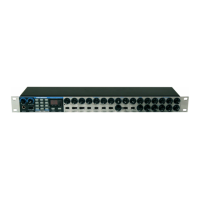It is recommended that this chapter is read carefully if Analogue
sound synthesis is an unfamiliar subject. Experienced users
can skip this chapter and move to the chapter - Main features
and Operation on Page 14.
Elements of a Sound
To gain an understanding of how a Synthesizer generates
sound it is helpful to have an understanding of the components
that make up a sound, be it musical or non musical.
The only way that a sound may be detected is by air vibrating
the eardrum in a regular, periodic manner. The brain interprets
these vibrations (very accurately) into one of an infinite number
of different types of sound.
Remarkably, any sound may be described by just three terms,
and all sounds always have them. They are :
* Volume
* Pitch
* Tone
What makes one sound different to another is how these three
terms change during the duration of the sound.
In a musical synthesizer we deliberately set out to have precise
control over these three terms and, in particular, how they can
be changed throughout the duration of the sound. These terms
are often given different names, Volume is referred to as
Amplitude, Pitch as Frequency and Tone as Timbre.
Pitch
Taking the example of air vibrating the ear drum, the pitch is
determined by how fast the vibrations are. For an adult human
the lowest vibration perceived as sound is about twenty times a
second, which the brain interprets as a bass type sound, and
the highest is many thousands of times a second, which the
brain interprets as a treble type sound.
Tone
Musical sounds consist of several different related pitches
occurring simultaneously. The loudest is referred to as the
‘Fundamental’ pitch Pitches related to the fundamental are
called harmonics. The relative loudness of these harmonics
compared to the loudness of all the other harmonics (including
the fundamental) determines the tone or ‘Timbre’ of the sound.
Volume
Volume, which is referred to as the amplitude or loudness of the
sound is determined by how large the vibrations are. Very sim-
ply, listening to a piano from a metre away would sound louder
than if it were fifty metres away.
8Synthesis Tutorial
Elements of a Sound
Wave A
Wave B
Time
Wave B is twice the Pitch of Wave A
Wave A
Wave B
Volume
Wave A is louder than Wave B but is the same pitch

